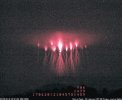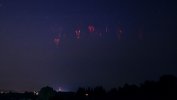Violent thunderstorms hit Germany on Thursday, June 22, 2017, producing gale-force winds, heavy rain and large hail. The storms caused widespread damage and traffic chaos, killed two people and severely injured at least one person. Contrary to numerous media reports, there was no tornado ripping through the city of Hamburg yesterday.
The first set of storms marched through the country during the early morning hours, damaging power lines and rail tracks, thus forcing trains to be halted between Berlin, Hamburg, Bremen, Kiel, and Hanover. Regional train provider Metronom said its services in the northwest were also affected after storms downed trees onto the tracks in several places.
The storms also affected and temporarily closed some of the busiest road routes connecting Hamburg with Berlin, Hanover and Wolfsburg.
Deutsche Welle reported that some planes departing overnight from Berlin were grounded at both of the capital's airports amid heavy rain. Those stranded at Tegel and Schönefeld airport were given blankets and water, while camper beds were also set up. At Schönefeld Airport normal service was expected to resume at around 09:00 local time. However, a speaker for the airport warned of potential further delays and urged travelers to check the status of their flight before departing for the airport.
The fire department was called to help in 250 different incidents in and around the major port city of Hamburg, while the eastern city of Magdeburg lost power in some areas after it was hit by a severe downburst.
A severe downburst also hit Harburg County, near the city of Hamburg, at around 11:30 CET (13:30 UTC), causing considerable damage and sending media into a frenzy after one fireman said it 'looks like after a tornado.' Soon after that, local, national and international media started publishing one article after another saying that a tornado swept through Hamburg. But that's not what happened. Think about it... The alleged tornado ripped through the second largest city in Germany (population 1.7 million) just before noon, but nobody took one single image? It didn't sound right so we talked with a well-known meteorologist Jörg Kachelmann of KachelmannWetter.com who kindly explained what really happened.
By the end of the day, at least 2 people were killed and one person severely injured.
"A 50-year-old man was killed when his car was struck by a tree in the town of Uelzen in Lower Saxony. Meanwhile, an 83-year-old woman died at Gifhorn, also in Lower Saxony, after her car hit a tree that had been blown across the street in strong gales. A cyclist was also severely injured by another tree nearby as the atypical weather pattern hit the region," Deutsche Welle reported.
The storms have since moved east over Poland, Czechia, Austria, Slovakia and Hungary. They are currently affecting Ukraine and Romania, on their way toward Moldova.







